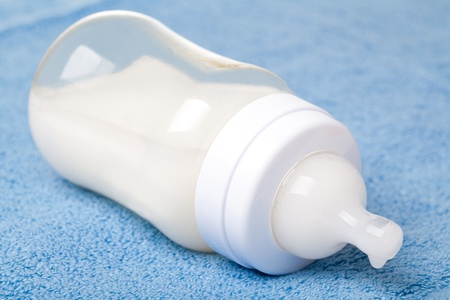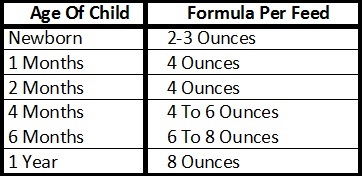Baby Bottle Feeding
The practice of putting the baby to the breast immediately after birth helps to initiate and promote breast feeding which is required by the baby to survive and grow. But there are many cases where breast feeding may not be possible. For example if the mother is unwell or admitted to the ICU due to some complication. If the child has a deformity like cleft lip he may be unable to feed. In all such cases the next best option is bottle feeding. There are many precautions that need to be taken for baby bottle feeding, irrespective of whether you give him breast milk or baby formula in a bottle.

Factors to Consider
Here is a complete baby bottle feeding guide to help you know about bottle feeding.
- Cleaning the Bottle: The first and most important step is to clean the bottle, nipple and other utensils. This is best done by sterilizing them. Baby bottles come in different sizes. You should go for the smaller ones that are 4-5 ounces when your baby is 1 to 3 months old. The size of the nipple also needs to be changed as the baby grows bigger. Never use a large hole nipple for a newborn as they cannot handle the fast flow of the milk and may gag.You must dip all the parts of the bottle and other utensils used for baby in a large vessel full of water and let it boil nicely for a few minutes. The boiling will help clean them of bacteria and make the bottle sterile. Then carefully remove the bottle and assemble it once the water cools down. You can also use a baby bottle sterilizer.
- Baby Formula: Selecting the right formula for babies is very crucial as your little one will be deriving all the nutrition from milk in the first few months. You may be thinking what’s the best formula for a baby. Most of the baby formula brands available in the market have a base of cow’s milk and are fortified to suit the needs of the baby. They are the next best option to breast milk. Whenever buying formula, make sure that you go for the iron fortified ones. Formula that has iron and DHA is the best milk formula for babies.
- Types of Formula: There are many types of formula available in the market. There is organic baby formula, ready to feed baby formula which is the most expensive of all. Another type if liquid concentrates which needs to be diluted with specific measurements. The commonest and most economical type of formula is the powder form where a fixed amount of the formula has to be reconstituted with boiled and cooled water which is the best water for baby formula.
- How Much Formula Should I Give: In case of a breast fed baby there is no fixed measurement to assess whether the child has had enough or how much he needs. It works on a need and supply basis and babies do just fine. But such is not the case with baby bottle feeding. Here is a month wise guide on how much formula or breast milk (pumped) the baby needs. This quantity can vary from one baby to the other. When you begin always give one or two ounces only as you do not know how the baby will react to it. Most of them tolerate it well but if you notice a change in the bowel habit, then you must consult your doctor.In the first three months, the baby will feed every 3 to 4 hours and so the number of feeds will be 6 to 7 in the whole day including night feeds. Gradually the gap between the feeds will increase as the baby will be able to hold the milk in the stomach for longer. By the age of 6 months babies will need only 4 to 5 feedings per day. By one year of age, the child will take all the foods that are prepared at home and need only 2-3 feedings of milk in the whole day.

Baby Feed
- Using Formula Correctly: There are some common mistakes that mothers make when handling formula. Here are a few things that you should take care of-If the baby has had some of the formula then it is not advisable to keep the unused formula. You must either feed it to the baby within one hour or else dispose it.If you put away formula in the refrigerator then you must heat it before giving the baby. This can be done by holding the bottle in a pan of boiling water. Formula must not be reheated in the microwave. Cheap baby bottles with low quality plastic can melt with the heat and cause toxins to enter the baby’s milk so you should be very careful about which bottles you buy. The plastic should be high quality and BPA free. Glass baby bottles are also available in the market for baby bottle feeding.
- Position Your Baby: When feeding the baby with a bottle always prop him up in a semi upright position. The best position would be to hold the baby in your arms with the head rested in the bend of your elbow. Tilt the bottle slightly to prevent the baby from swallowing air. You should never give a bottle to the baby in lying down position as it increases the chance of the baby getting an ear infection. There are bottle props available these days for baby bottles but you should avoid using them as they can be a choking hazard.
- Monitor The Intake: Always keep a mental check on your baby’s feeding. Formula is heavier compared to breast milk and takes longer to digest. You may notice that exclusively formula fed babies can go longer hours between two feeds. When baby bottle feeding, you need to go by your baby’s cues. If the baby refuses the bottle after half the feed, do not insist on finishing, wait for an hour and offer the milk again. If he is sucking hard after the milk is over, he could be hungry so offer an ounce or two more. When you take the baby to the doctor, this is one of the things that he will ask you. The number of feedings and the urine output (this can be assessed by the number of wet diapers your baby is making) are important indicators of the baby’s well being.
- Burp The Baby: Babies tend to swallow air while feeding. In breast fed infants this happens if the latch to the breast is improper. In bottle fed babies if you notice fussiness or disinterest in feeding it could be because of gas. Take your little one and hold him upright with chin resting on your shoulder. Gently press the back, the air will escape in the form of a burp. Do this between feeds and you will notice that the throwing up of milk after a feed will no longer be a problem. Remember to burp the baby after each feed.




